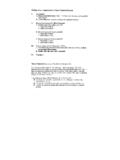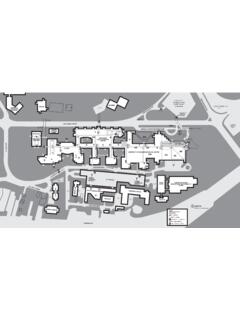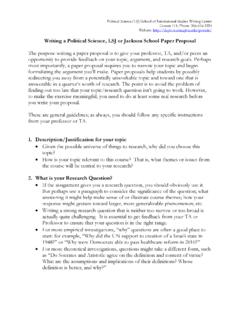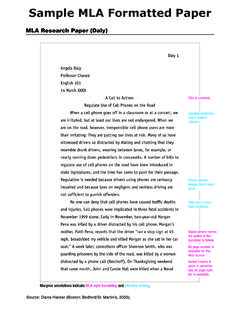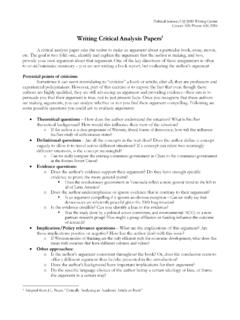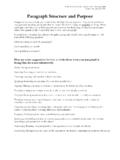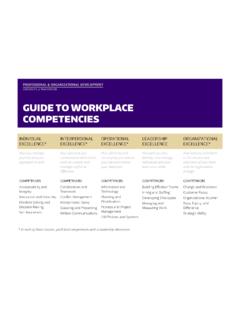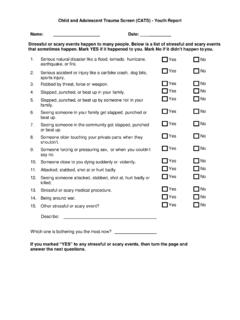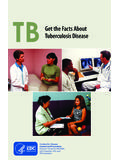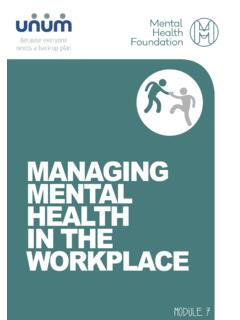Transcription of What is Anxiety?
1 What is Anxiety? Information for clients and their families Anxiety is intense feelings of being afraid, nervous, tense or worried that are too strong for the situation, go on too long and get in the way of normal life. Being afraid is normal for survival in situations of real danger but sometimes the feelings are transferred to situations that are not actually dangerous. The same is true about worry. Worrying can be helpful when it is important to be prepared and consider possible things that could go wrong. But worrying about many things all the time is unhelpful and distressing. All anxiety problems involve being overly afraid or worried. When fear and worry are not necessary, are too strong and interfere with life it is a problem and important to get help. There are several different types of anxiety disorders. The type of anxiety is related to what the fears and worries are about and how they are handled.
2 For example, separation anxiety is extreme worry that something bad will happen if the child is separated from the parent ( , school). Generalized anxiety is having extreme and constant worries about a lot of different things. Social anxiety is extreme fear of being humiliated in social situations. Phobias are unrealistic and extreme fears of situations or things ( , snakes, flying). Panic is the fear of dying or having a heart attack because of physical feelings of anxiety. Anxiety is a very common mental health problem. Between 5-10% of children have an anxiety condition. Signs and Symptoms Feelings heart pounding nausea or stomach aches numbness trouble concentrating outbursts of irritability or anger jumpiness trouble falling or staying asleep trouble breathing sweating dizzy, faint or lightheaded muscle tension trembling and shaking Thoughts thinking that danger is everywhere; a thing or situation is very dangerous when it is not worrying way too much about bad things happening constant thoughts or images of bad things happening Behavior avoiding situations, people or things ( , flying, social situations, memories).
3 Clinging to safe people or refusing to leave them temper tantrums or outbursts when faced with separation or feared situations repetitive rituals Causes of Anxiety Anxiety isn't caused by any one thing, but is usually happens because of a combination of things. It can be caused by bad experiences, stress, chronic illness, or chemicals in the brain (not working like they should). Instability and unpredictability at home or in the community are CBT+. common causes. Or it can seem to come out of the blue. Anxiety can run in families, so someone with a close relative who has anxiety may be more likely to experience it. When to get Help for Anxiety Since everyone feels scared, anxious or worried sometimes, it is important to pay attention when the feelings, thoughts and behaviors are very intense, go on too long and get in the way of being able to do what you normally do.
4 The main way that people handle anxiety is by avoiding facing up to fears and worries. This coping approach works very well in the moment because it lowers the anxious feelings right away ( , staying home, not going into social situations). The problem is that avoiding never solves the problem of unrealistic or too intense fears and worries. Avoidance can become a problem in itself. Avoiding things you are afraid of gets in the way of normal life like going to school and having friends. Other times, avoidance can be risky or harmful. For example, a teenager may drink or take drugs to avoid or lessen anxious feelings. Sometimes, even engaging in risky behavior or self harming behavior can be a form of avoiding facing up to fears and worries. Get help right away when: You are doing things on purpose to hurt yourself. You are drinking and taking drugs to block out negative feelings.
5 Treatment for Anxiety The good news is that there is help for anxiety. There are 2 different types of treatment that work. 1. Cognitive behavioral therapy (CBT). CBT is a time-limited, problem-focused intervention that teaches how to change unhelpful or unrealistic thoughts and how to learn new behaviors like calming coping skills, and taking steps toward facing up to fears and worries and finding out that it is possible to lessen anxious feelings. The therapist and client identify the specific type of anxiety, the unhelpful thoughts and behaviors, and come up with new ones to practice and try out. 2. Antidepressant medicine. These medicines work on the brain and uplift and calm down moods. Medicine is usually not the only treatment but can be taken along with doing therapy. The majority of people who are anxious can recover and be back to normal with 10-20 sessions of therapy, often without medication.
6 It's important to know that CBT is a treatment that requires active participation and practicing new ways of thinking and behaving to work. Just like medicine only works when it is taken, therapy only works when clients do things a new way. Be a good consumer: 1. Ask the therapist what kind of therapy is available; get a description of what is involved in the therapy ( , how long, how to know when better, what skills are learned). 2. Is there practice? Remember, learning new thoughts and behaviors is the cure . Therapy should include practice between sessions. CBT+. 3. Effective anxiety treatments always involve facing up to fears and worries and learning that they can be handled. If the treatment does not involve facing up to fears it is not likely to work. 4. If you don't start feeling better, start asking questions and consider options. CBT+.

